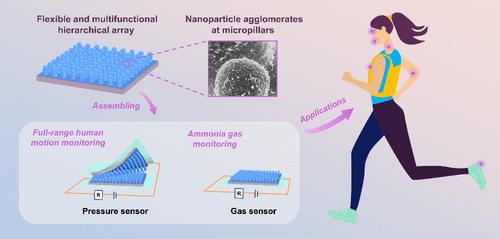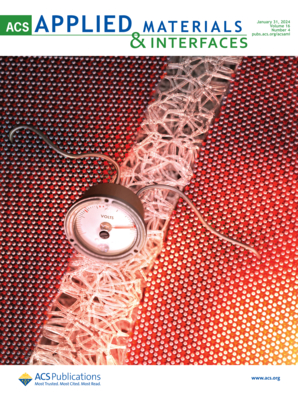采用聚吡咯涂层热塑性聚氨酯分层阵列的柔性多功能压力/气体传感器
IF 8.3
2区 材料科学
Q1 MATERIALS SCIENCE, MULTIDISCIPLINARY
引用次数: 0
摘要
本文提出了一种制造柔性压力/气体传感器的可行策略,这种传感器的传感基底上的微柱具有微突起和微皱纹结构。传感基底是通过压缩成型热塑性聚氨酯(TPU,一种工业级聚合物)和随后的吡咯聚合制备的。得益于传感基底上的分层结构,柔性传感器在检测压力和氨气(NH3)方面都表现出很高的性能。对压力传感器分层结构的功能机理进行了分析。这种独特的分层结构使在 60 分钟聚合时间内制备的基底组装成的联锁压力传感器在更宽的线性范围(1.15 kPa-1,0-800 Pa)内具有相对较高的灵敏度,检测极限较低,为 6.2 Pa,响应和恢复时间较短(26/28 ms)。热塑性聚氨酯和聚吡咯层之间更强的界面相互作用、互锁微柱的相互支持以及热塑性聚氨酯固有的高回弹性,使压力传感器具有更低的滞后性、良好的重复性和稳定性以及更高的耐用性(10,000 次循环)。这种互锁式压力传感器可以全方位检测人体生理活动,从微弱的生理信号(如面部肌肉收缩、心跳和呼吸)到身体运动(如头部、肘部和脚部运动)。用 60 分钟聚合时间制备的分层传感基底组装的气体传感器对 NH3 具有选择性、稳定性和更快的传感响应。所提出的制备策略既简便又具有成本效益,是制造高性能、多功能传感器的理想选择。本文章由计算机程序翻译,如有差异,请以英文原文为准。

Flexible and Multifunctional Pressure/Gas Sensors with Polypyrrole-Coated TPU Hierarchical Array
A promising strategy is proposed for fabricating flexible pressure/gas sensors, which have a microprotuberance and microwrinkle structure at micropillars on their sensing substrates. The sensing substrates were prepared by compression molding thermoplastic polyurethane (TPU; an industrial grade polymer) and subsequent pyrrole polymerization. Benefiting from the hierarchical structure on the sensing substrates, the flexible sensors exhibit high performances in detecting both pressure and ammonia (NH3). Mechanism for the functionalities of the hierarchical structure of the pressure sensors was analyzed. Such unique hierarchical structure endows the interlocked pressure sensor by assembling the substrates prepared at 60 min polymerization time with a relatively high sensitivity in a wider linearity range (1.15 kPa–1, 0–800 Pa), a lower detection limit of 6.2 Pa, and shorter response and recovery times (26/28 ms). The combination of stronger interfacial interaction between the TPU and polypyrrole layer, the mutual support of the interlocked micropillars, and the inherent high resilience of TPU endows the pressure sensor with lower hysteresis, good repeatability and stability, and higher durability (10,000 cycles). The interlocked pressure sensor can detect full-range human physiological activities from weak physiological signals (such as face muscle contraction, heartbeat, and breath) to body movements (such as head, elbow, and foot movement). The gas sensor assembled with the hierarchical sensing substrate prepared at 60 min polymerization time exhibits selective, stable, and faster sensing responses to NH3. The proposed facile and cost-effective preparation strategy can be an excellent candidate for fabricating high-performance and multifunctional sensors.
求助全文
通过发布文献求助,成功后即可免费获取论文全文。
去求助
来源期刊

ACS Applied Materials & Interfaces
工程技术-材料科学:综合
CiteScore
16.00
自引率
6.30%
发文量
4978
审稿时长
1.8 months
期刊介绍:
ACS Applied Materials & Interfaces is a leading interdisciplinary journal that brings together chemists, engineers, physicists, and biologists to explore the development and utilization of newly-discovered materials and interfacial processes for specific applications. Our journal has experienced remarkable growth since its establishment in 2009, both in terms of the number of articles published and the impact of the research showcased. We are proud to foster a truly global community, with the majority of published articles originating from outside the United States, reflecting the rapid growth of applied research worldwide.
 求助内容:
求助内容: 应助结果提醒方式:
应助结果提醒方式:


